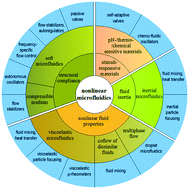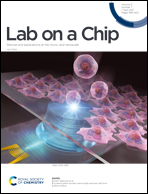Nonlinear microfluidics: device physics, functions, and applications
Abstract
The microfluidic flow is typically laminar due to the dominant viscous effects. At Reynolds numbers far below 1 (Re ≪ 1), the fluid inertia can be neglected. For the steady flow of incompressible Newtonian fluids, it approaches linear Stokes flow. At intermediate Re, there exists a weak-inertia flow regime where secondary flows such as Dean vortices are accessible for microfluidic manipulations. Apart from the fluid inertia, other nonlinear factors such as the non-Newtonian fluid properties, concurrent flow of dissimilar fluids, compliant fluidic structures and stimuli-responsive materials can also cause intriguing flow behaviours. Through proper designs, they can be applied for a variety of microfluidic components including mixers, valves, oscillators, stabilizers and auto-regulators etc., greatly enriching the microfluidic flow control and manipulation strategies. Due to its unique working characteristics and advantages, nonlinear microfluidics has increasingly attracted extensive attention. This review presents a systematic survey on this subject. The designs of typical nonlinear microfluidic devices, their working mechanisms, key applications, and the perspective of their future developments will be discussed. The nonlinear microfluidic techniques are believed to play an essential role in the next generation of highly-integrated, automated, and intelligent microfluidics.



 Please wait while we load your content...
Please wait while we load your content...